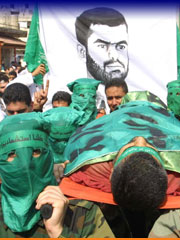The Force and Farce of International Law
1.
The year is 1992. Iran has just blown up the Israeli Embassy in Argentina, an event little remembered today. Algeria -- which last month sponsored the U.N. Security Council resolution condemning Israel's assassination of Hamas leader Sheikh Ahmed Yassin as a violation of international law -- has cancelled a democratic election that was about to be won by an Islamicist Party, declared martial law, and has sunk into what would become a ten-year civil war against Islamic radicals that featured heinous acts of terrorism, torture, mass executions, and so many "disappearances" that just last year Human Rights Watch declared Algeria to be the world leader in them. And, in the final months of the year, Israeli Prime Minister Yitzhak Rabin has rounded up 416 Hamas leaders and activists and deported them to Lebanon, dumping them on a hilltop in the no-man's land between Israeli and Lebanese lines.
The world howled. Israel was accused -- in countless newspaper editorials as well as by United Nations Resolution 799 (with America's vote) -- of violating international law and due process. Israel had no right to round up these men and deport them without a trial. Worse, since Lebanon refused to admit them, they were left to survive on their windswept hill in makeshift tents, thereby creating a humanitarian crisis as well as a public relations fiasco. Major newspapers all of the world featured images such as one that graced the pages of Libération of a shivering Hamas exile reaching out to the viewer in a supplication reminiscent of Goya's moving May 3rd, 1808. Accompanying the Hamas pieta was an article that echoed so many of the editorials current at the time; it spoke not just of the basic injustice of the deportation but the fact that the Hamas members in question were all educated university types, suggesting, implicitly, that Israel's fear of them was out of proportion. ( Libération and many French papers also referred to the Hamas exiles as déportés, which in contemporary usage refers to Jewish victims of the Holocaust; an analogy is when people refer to Guantanamo Bay as a "concentration camp.")
Meanwhile, French papers from that time also noted, invariably without comment, in small articles buried somewhere toward the back, that Algerian security forces were rounding up militants and shooting them. Extrajudicially. Needless to say, no global outrage.
Time passed. Under intense international pressure, Rabin let more and more of the Hamas exiles back into Israel, eventually bringing them all back as part of the Oslo Accord in September 1993.
What's become of these men, these university-educated victims of Israeli aggression? Let's check in with the Class of 1992, to see how they're doing.
First, although the first Hamas suicide bomb attack dates to April, 1993, the campaign only began in earnest after the militants had all returned, in 1994. (This was the same year that Iran, via Hezbollah and with the complicity of the Argentinean police, bombed the Jewish community center in Buenos Aires, killing 87, and the same year that the radical Algerian GIA, which many have linked to the Algerian government, hijacked an Air France plane with the intention of flying it into the Eiffel Tower. French commandos successfully raided the jet and killed the terrorists.) This coincidence of timing bore out Israel's rationale for the deportation in the first place: that Hamas was now a ticking time bomb. A terrorist group of the first order. Does anyone remember this rationale today?
 It is impossible to know what happened to all 416 alumni of the Lebanese exile. Perhaps many of them have spent the past twelve years at home, tending their gardens. What is clear, however, is that they have had a prominent place in the suicide bombing campaign; they are not the "martyrs" themselves who carry the bombs, but the commanders, managers, and organizers of the attacks.
It is impossible to know what happened to all 416 alumni of the Lebanese exile. Perhaps many of them have spent the past twelve years at home, tending their gardens. What is clear, however, is that they have had a prominent place in the suicide bombing campaign; they are not the "martyrs" themselves who carry the bombs, but the commanders, managers, and organizers of the attacks.
Rahman Hamad is a typical example. He organized the bombing of the No. 5 bus in Tel Aviv in 1994, which killed 24 people. Under Israeli pressure, the Palestinian Authority arrested him but then let him go. He then planned and dispatched the bomber in the attack on the Dolphinarium disco, and he killed two boys at a gas station in Neve Yamim in 2001. (The photo here is of Hamad after an Israeli sniper killed him in late 2001.)

Another alumnus, Jamal Mansour, ran suicide bomb operations in the northern West Bank, where he oversaw its implementation, targeting, and infrastructure. Jamal Dmouni became Hamas commander in Samaria, where he oversaw Mansour.



The Hamas Class of 1992
Michael Shurkin
Every City has a Soul
Jill Hammer
Wagner in Israel
Margaret Strother
Wrestling with Steve Greenberg
Jay Michaelson
T Cooper
Abi Cohen
The Stable
Ira Stone
Archive
Our 450 Back Pages
Saddies
David Stromberg
Zeek in Print
New Spring 2004 issue now on sale!
About Zeek
News & Events
Contact Us
Tech Support
Links
From previous issues:
A Song of Ascents
Sarah Lefton
The Failure of Anti-Despotism
Justin Weitz
Mourning in America
Samuel Hayim Brody